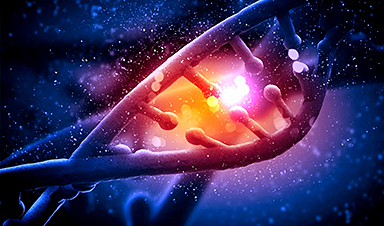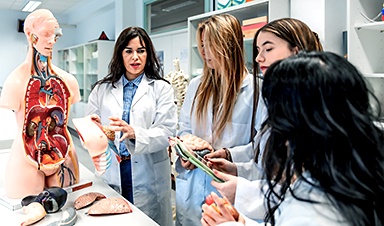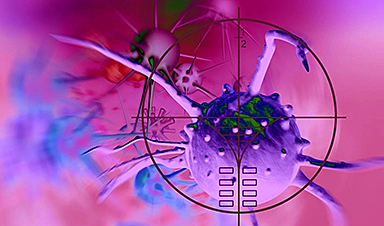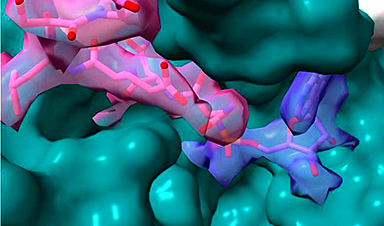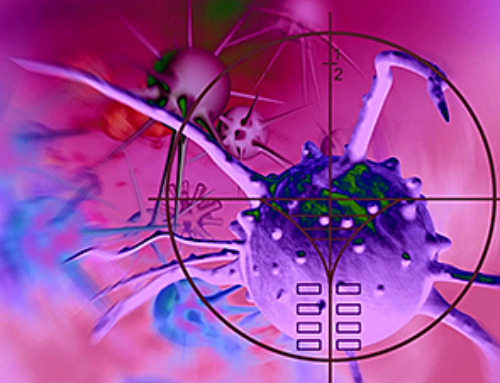DNA is crucial for life, and its organization has been a significant scientific challenge. GROVER, a model developed by BIOTEC, decodes DNA like text, promising advancements in genomics and personalized medicine.
DNA holds the essential information required to sustain life. Deciphering how this information is stored and organized has been one of the greatest scientific challenges of the past century. Now, with GROVER, a new large language model trained on human DNA, researchers can attempt to decode the intricate information concealed within our genome. Developed by a team at the Biotechnology Center (BIOTEC) of Dresden University of Technology, GROVER treats human DNA as text, learning its rules and context to extract functional information about DNA sequences. Published in Nature Machine Intelligence, this innovative tool has the potential to revolutionize genomics and accelerate personalized medicine.
Since the discovery of the double helix, scientists have sought to understand the information encoded in DNA. 70 years later, it is clear that the information hidden in the DNA is multilayered. Only 1-2 % of the genome consists of genes, the sequences that code for proteins.
“DNA has many functions beyond coding for proteins. Some sequences regulate genes, others serve structural purposes, and most sequences serve multiple functions at once. Currently, we don’t understand the meaning of most of the DNA. When it comes to understanding the non-coding regions of the DNA, it seems that we have only started to scratch the surface. This is where AI and large language models can help,” says Dr. Anna Poetsch, research group leader at the BIOTEC.
DNA as a Language
Large language models, like GPT, have transformed our understanding of language. Trained exclusively on text, the large language models developed the ability to use the language in many contexts.
“DNA is the code of life. Why not treat it like a language?” says Dr. Poetsch. The Poetsch team trained a large language model on a reference human genome. The resulting tool named GROVER, or “Genome Rules Obtained via Extracted Representations”, can be used to extract biological meaning from the DNA.
“GROVER learned the rules of DNA. In terms of language, we are talking about grammar, syntax, and semantics. For DNA this means learning the rules governing the sequences, the order of the nucleotides and sequences, and the meaning of the sequences. Like GPT models learning human languages, GROVER has basically learned how to ‘speak’ DNA,” explains Dr. Melissa Sanabria, the researcher behind the project.
The team showed that GROVER can not only accurately predict the following DNA sequences but can also be used to extract contextual information that has biological meaning, e.g., identify gene promoters or protein binding sites on DNA. GROVER also learns processes that are generally considered to be “epigenetic”, i.e., regulatory processes that happen on top of the DNA rather than being encoded.
“It is fascinating that by training GROVER with only the DNA sequence, without any annotations of functions, we are actually able to extract information on biological function. To us, it shows that the function, including some of the epigenetic information, is also encoded in the sequence,” says Dr. Sanabria.
The DNA Dictionary
“DNA resembles language. It has four letters that build sequences and the sequences carry a meaning. However, unlike a language, DNA has no defined words,” says Dr. Poetsch. DNA consists of four letters (A, T, G, and C) and genes, but there are no predefined sequences of different lengths that combine to build genes or other meaningful sequences.
To train GROVER, the team had to first create a DNA dictionary. They used a trick from compression algorithms. “This step is crucial and sets our DNA language model apart from the previous attempts,” says Dr. Poetsch.
“We analyzed the whole genome and looked for combinations of letters that occur most often. We started with two letters and went over the DNA, again and again, to build it up to the most common multi-letter combinations. In this way, in about 600 cycles, we have fragmented the DNA into ‘words’ that let GROVER perform the best when it comes to predicting the next sequence,” explains Dr. Sanabria.
The Promise of AI in Genomics
GROVER promises to unlock the different layers of genetic code. DNA holds key information on what makes us human, our disease predispositions, and our responses to treatments.
“We believe that understanding the rules of DNA through a language model is going to help us uncover the depths of biological meaning hidden in the DNA, advancing both genomics and personalized medicine,” says Dr. Poetsch.
Reference: “DNA language model GROVER learns sequence context in the human genome” by Melissa Sanabria, Jonas Hirsch, Pierre M. Joubert and Anna R. Poetsch, 23 July 2024, Nature Machine Intelligence.
DOI: 10.1038/s42256-024-00872-0
News
Most Plastic in the Ocean Is Invisible—And Deadly
Nanoplastics—particles smaller than a human hair—can pass through cell walls and enter the food web. New research suggest 27 million metric tons of nanoplastics are spread across just the top layer of the North [...]
Repurposed drugs could calm the immune system’s response to nanomedicine
An international study led by researchers at the University of Colorado Anschutz Medical Campus has identified a promising strategy to enhance the safety of nanomedicines, advanced therapies often used in cancer and vaccine treatments, [...]
Nano-Enhanced Hydrogel Strategies for Cartilage Repair
A recent article in Engineering describes the development of a protein-based nanocomposite hydrogel designed to deliver two therapeutic agents—dexamethasone (Dex) and kartogenin (KGN)—to support cartilage repair. The hydrogel is engineered to modulate immune responses and promote [...]
New Cancer Drug Blocks Tumors Without Debilitating Side Effects
A new drug targets RAS-PI3Kα pathways without harmful side effects. It was developed using high-performance computing and AI. A new cancer drug candidate, developed through a collaboration between Lawrence Livermore National Laboratory (LLNL), BridgeBio Oncology [...]
Scientists Are Pretty Close to Replicating the First Thing That Ever Lived
For 400 million years, a leading hypothesis claims, Earth was an “RNA World,” meaning that life must’ve first replicated from RNA before the arrival of proteins and DNA. Unfortunately, scientists have failed to find [...]
Why ‘Peniaphobia’ Is Exploding Among Young People (And Why We Should Be Concerned)
An insidious illness is taking hold among a growing proportion of young people. Little known to the general public, peniaphobia—the fear of becoming poor—is gaining ground among teens and young adults. Discover the causes [...]
Team finds flawed data in recent study relevant to coronavirus antiviral development
The COVID pandemic illustrated how urgently we need antiviral medications capable of treating coronavirus infections. To aid this effort, researchers quickly homed in on part of SARS-CoV-2's molecular structure known as the NiRAN domain—an [...]
Drug-Coated Neural Implants Reduce Immune Rejection
Summary: A new study shows that coating neural prosthetic implants with the anti-inflammatory drug dexamethasone helps reduce the body’s immune response and scar tissue formation. This strategy enhances the long-term performance and stability of electrodes [...]
Scientists discover cancer-fighting bacteria that ‘soak up’ forever chemicals in the body
A family of healthy bacteria may help 'soak up' toxic forever chemicals in the body, warding off their cancerous effects. Forever chemicals, also known as PFAS (per- and polyfluoroalkyl substances), are toxic chemicals that [...]
Johns Hopkins Researchers Uncover a New Way To Kill Cancer Cells
A new study reveals that blocking ribosomal RNA production rewires cancer cell behavior and could help treat genetically unstable tumors. Researchers at the Johns Hopkins Kimmel Cancer Center and the Department of Radiation Oncology and Molecular [...]
AI matches doctors in mapping lung tumors for radiation therapy
In radiation therapy, precision can save lives. Oncologists must carefully map the size and location of a tumor before delivering high-dose radiation to destroy cancer cells while sparing healthy tissue. But this process, called [...]
Scientists Finally “See” Key Protein That Controls Inflammation
Researchers used advanced microscopy to uncover important protein structures. For the first time, two important protein structures in the human body are being visualized, thanks in part to cutting-edge technology at the University of [...]
AI tool detects 9 types of dementia from a single brain scan
Mayo Clinic researchers have developed a new artificial intelligence (AI) tool that helps clinicians identify brain activity patterns linked to nine types of dementia, including Alzheimer's disease, using a single, widely available scan—a transformative [...]
Is plastic packaging putting more than just food on your plate?
New research reveals that common food packaging and utensils can shed microscopic plastics into our food, prompting urgent calls for stricter testing and updated regulations to protect public health. Beyond microplastics: The analysis intentionally [...]
Aging Spreads Through the Bloodstream
Summary: New research reveals that aging isn’t just a local cellular process—it can spread throughout the body via the bloodstream. A redox-sensitive protein called ReHMGB1, secreted by senescent cells, was found to trigger aging features [...]
AI and nanomedicine find rare biomarkers for prostrate cancer and atherosclerosis
Imagine a stadium packed with 75,000 fans, all wearing green and white jerseys—except one person in a solid green shirt. Finding that person would be tough. That's how hard it is for scientists to [...]
